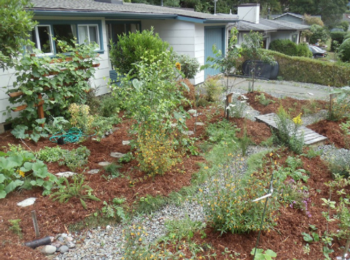Rain gardens: attractive solution to an environmental challenge
-
 Permeable surfaces allow rainwater to soak in, slow down, and spread out
Permeable surfaces allow rainwater to soak in, slow down, and spread out
Before there were buildings, paved roads and parking lots, rain percolated down through layers of sand and soil and eventually entered the water table below. Today when rain falls on buildings and paved surfaces, it runs around them, often causing serious erosion, pollution and even flooding. Rain gardens reduce runoff, look beautiful and are easy to create.
Downsides of storm drains and runoff
In the Bay Area, the water that sloshes into storm drains typically flows into streams, eventually flowing into the bay. Expensive to build, storm drains collect water that often contains petrochemicals, pesticides and herbicides. The runoff is often warmer than the water in rivers, streams, lakes or ocean, which can result in the death of native species or the growth of destructive plants or algae.By channeling rainwater into the bay rather than letting it soak into the earth, we deplete our groundwater. This is the water that flows beneath the earth's surface and is typically discharged through springs and seeps. Reduced groundwater leads to expensive, deeper wells and also negatively affects our quantity of water in streams, ponds, and lakes.
Finally, runoff accelerates erosion, intensifies pollution, and increases the risk of flooding. Like a magnet, flowing water grabs whatever debris is in its path. Runoff also can lead to drastic flooding with expensive consequences, as seen recently in the Ross Valley.
Origin – and impact - of rain gardens
In 1990, while designing a subdivision in Prince George's County in Maryland, David Brinker developed a plan to collect rainwater in gardens, rather than directing it to run off into storm drains. One immediate benefit of these "rain gardens" was economic: the cost to build storm drains for the subdivision would have been $400,000, but the cost of a rain gardens was only $100,000. The gardens were also aesthetically pleasing, and the water was retained in the local soil. Remarkably, the rain gardens reduced storm water runoff by as much as 75-80%.Create your own rain garden
Rain gardens allow water to sink into the ground in about 48 hours. Creating your own rain garden is simple:- Identify where water runs off your home or driveway: Check all drain spouts from the gutters that run along the edge of your roof. A pipe may be used to carry the water away from the foundation of the house to a garden area.
- Install more permeable surfaces: Any surface that allows water to seep through it or around it is permeable. Some obvious examples are bare soil, mulched beds, and gravel. Stone, pavers and concrete can also be permeable, so long as there are crevices where water can percolate. There has been an explosion of permeable materials available, including porous cement concrete, porous asphalt concrete, and pavers that are specially designed to allow water to flow through. Stop by your local landscape supplier for samples.
- Add plants that help contain water long enough for it to sink into the ground: Make sure the plants can tolerate damp roots during the rainy season. Robust native plants that grow at the edge of wetlands, such as sedges, rushes, ferns, select shrubs and small trees, will do well in these conditions. If a low-lying area contains water much of the time, it is called a wetlands rather than a rain garden. Here’s where you can find a list of plants that are suitable for rain gardens.
For more ideas on designing and building a rain garden, refer to the following resources:
- UC Agriculture and Natural Resources document, Coastal California Rain Gardens
- Sonoma Master Gardeners’ Rain gardens: practical and beautiful
- UC Cooperative Extension’s How to build a rain gardenOriginal articles by Barbara Euser and Marie Narlock for the Marin Independent Journal
Edited by Julie McMillan for The Leaflet
Photo courtesy of UCANR

